
A Week Full of Economic Data to Watch
Despite a moderate growth rate, the resurgence of inflation shifted market sentiment in the U.S., while the post-election calm contributed to a more rational market environment. In China, positive data—including forecasts for further rate cuts and economic stimulus—supported an optimistic outlook, whereas Japan’s GDP growth fell short of expectations. Overall, last week’s data were solid, showing increased consumer spending in anticipation of the new year. Next week, U.S. housing market data will take center stage, while in Europe, attention should be on PMI and inflation figures. Additionally, remarks from central bank officials throughout the week will be crucial.
Upcoming Economic Calendar Highlights:
- Monday: Japan’s September machinery orders, October chain store sales, and Canada’s October housing starts.
- Tuesday: October CPI figures for the Eurozone and Canada.
- Wednesday: October trade data for Japan and CPI rates for the UK.
- Thursday: UK’s CBI industrial orders trends for November, U.S. weekly initial jobless claims, November’s Philly Fed Business Index, and Eurozone’s preliminary November consumer sentiment.
- Friday: Preliminary November PMI data for Australia, Japan, France, Germany, the Eurozone, the UK, and the U.S., as well as Japan’s October CPI rates, UK retail sales for October, Canada’s September retail sales, and November’s U.S. University of Michigan Consumer Sentiment Index.
USA
October’s Consumer Price Index (CPI) rose 0.24%, printing the largest monthly increase since April and bringing the annual inflation rate to 2.6%. Core services, especially shelter costs, continue to show stubborn price growth, while non-shelter services like airfare and motor vehicle maintenance also contributed to the rise. In addition, with a 0.2% PPI increase in October and September’s number revised to 0.1% (from an initial 0%), we can now say with more certainty that inflation is gradually declining, though progress is slowing. The Producer Price Index (PPI) also suggests potential upward pressure on future inflation.
Following September’s significant rate cut, the NFIB Small Business Optimism Index showed growth; however, actual business conditions remain weak, with hiring plans stalling and sales falling to the lowest level since 2020. Additionally, industrial production fell by 0.3% in October, continuing the weak activity seen in September, and manufacturing output remains below 2017 levels. It is important to consider the effects of labor strikes and hurricanes.
In the week ahead, housing market data in the U.S. economy will be in focus. As for macroeconomic and fundamental changes, we will need to follow the president-elect’s proposed candidates for various administrations and Fed speakers.
In the housing market, total housing starts fell by 0.5% in September after a strong August. Single-family starts continued to rise, supported by an uptrend in permits, but multifamily development struggled. October is expected to see a further 0.7% decline, with high mortgage rates still posing challenges despite anticipated gradual improvements from the Fed’s easing measures. Regarding sales, existing home sales fell 1.0% in September to a 3.84M annual pace, the slowest since 2010, due to high prices and mortgage rates. For October, a 2.1% increase to 3.92M units is projected, with positive signs from rising pending home sales. However, elevated mortgage rates (around 6.80%) and recent hurricanes may limit recovery.
With these data, we expect the Fed to continue its rate cuts in the December meeting, but in the long term, we should be more cautious about future decisions and outlooks, which will also be reflected in the dot plots. Given these outlooks, we expect the downward pressure from the previous week to continue. From a technical point of view, if the S&P 500 falls below the key pivot of 5,870, the next steps could be around 5,820 and then 5,775. Last week, the S&P 500 fell 2.08%, the Nasdaq declined 3.15%, and the Dow lost 1.24%.
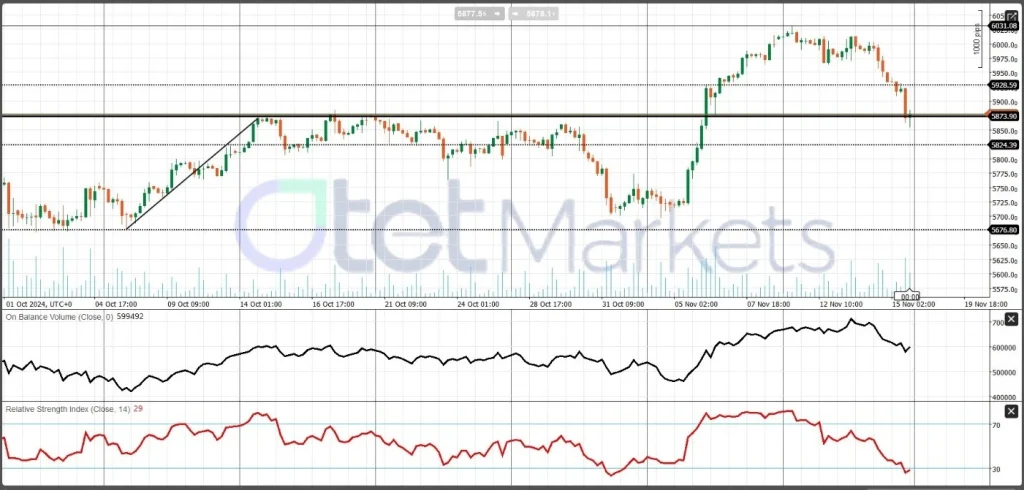
As for the U.S. dollar, should U.S. economic isolationist tendencies become more pronounced in the coming week, we may see them supporting the USD further. However, the cautious outlook from the Federal Reserve and its speakers has helped the dollar in recent days, and this is expected to slow down in the week ahead. From a technical point of view, the trend line is broken, OBV creates a new lower high, and RSI indicates a weakening trend strength, all signaling a possible correction.
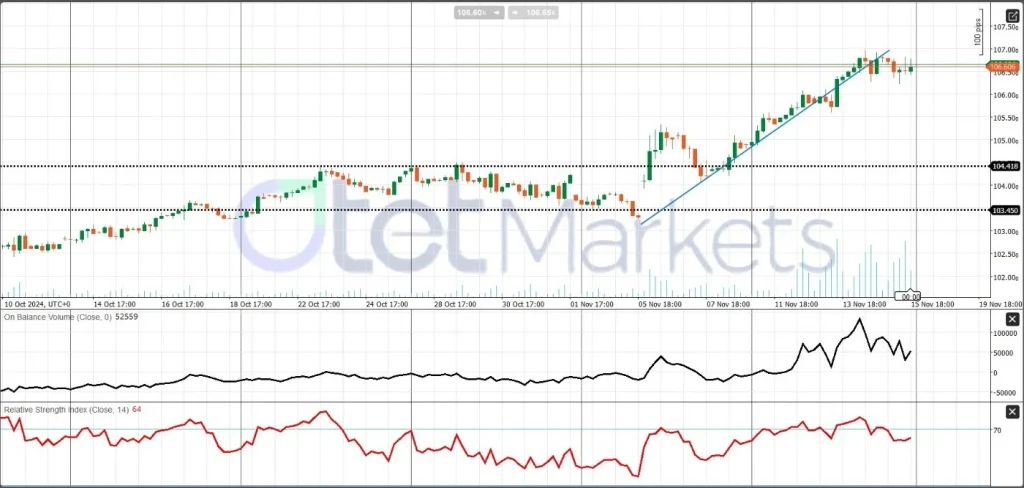
Eurozone and Euro
Last week was not a busy week in the Eurozone, but the important data we did have were again mostly disappointing. In Q3 2024, the Eurozone’s GDP data reflected steady economic performance. The year-over-year (YoY) growth rate stood at 0.9%, matching both forecasts and the previous quarter’s figure, indicating consistent annual growth. Similarly, the quarter-over-quarter (QoQ) growth was 0.4%, also in line with expectations and unchanged from the prior quarter. These results point to a stable, albeit moderate, pace of economic expansion within the Eurozone, without significant changes in momentum. Additionally, we had the ZEW Report from Germany and the Eurozone for November. Missing the ZEW Current Conditions and Economic Sentiment suggests that economic confidence within the broader Eurozone is weakening, hinting at shared economic pressures across the region. Overall, the ZEW report highlights growing pessimism both in the current conditions and future expectations, signaling possible headwinds for Germany and the Eurozone as they navigate economic uncertainties.
For the week ahead, we need to focus on PMI numbers. Market participants are awaiting the November Eurozone PMIs to gauge the region’s economic health. While Eurozone growth was stable in Q3, recent sentiment surveys suggest stagnation ahead, with mixed PMI readings from October. The services PMI showed a slight increase, while the manufacturing PMI remained weak, indicating contraction.
For November, economists expect the services PMI to hold steady at 51.6, and manufacturing to rise slightly to 46.1, suggesting steady sentiment but limited optimism for future growth. Economic softness in the Eurozone is seen as primarily driven by local conditions, with potential risks from tariffs under President-elect Trump. The region’s economy is expected to grow by just 0.6% in 2024, improving to 1.1% in 2025.
In addition, we have the inflation data to watch. We do not expect any surprises in the inflation numbers. Both CPI and Core CPI are expected to increase at the same pace as in September, remaining unchanged at 2.0% and 2.7%, respectively.
As for monetary policy expectations, we expect the European Central Bank (ECB) to cut rates by 25 basis points in December, with a quarterly reduction cadence afterward. If growth challenges intensify, a faster pace of easing may occur.
Given the data we have and estimates from the upcoming data, the Euro outlook is not bright, but we still expect a correction in the EUR/USD chart after the recent fall. The initial support sits at 1.0470, with resistance and the next target after recovery at 1.0680.
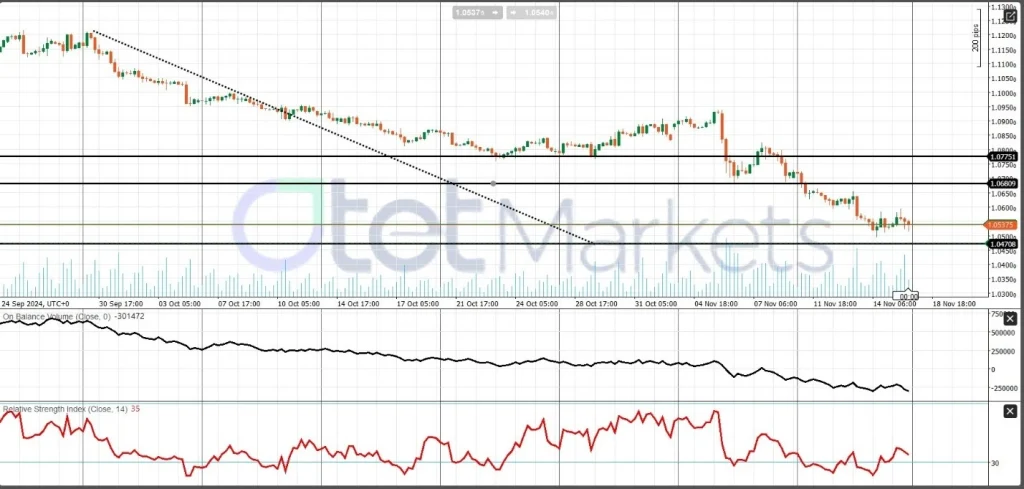
Gold Market Insight: Pressured by Rate Expectations and Dollar Strength
Gold faced its steepest weekly drop since 2021, down over 4%, pressured by signals from the Federal Reserve and macroeconomic factors. The Fed’s cautious approach to interest-rate cuts, supported by Fed Chair Jerome Powell’s comments on the resilience of the U.S. economy, pushed U.S. Treasury yields and the dollar to multi-month highs, creating headwinds for gold. Market participants reduced expectations for a December rate cut after Powell’s remarks and sticky U.S. inflation data for October. The CME FedWatch tool indicated a drop in rate cut probability from 85.7% to 62%, with a growing 38% chance that rates could remain unchanged. The week ended with a 4.444% U.S. 10-year Treasury Note Yield.
The aftermath of President-elect Trump’s re-election also weighed on gold, as his policy outlook suggested potential inflationary measures, such as higher tariffs and fiscal expansion, boosting yields and the dollar. A risk-on sentiment driven by Trump’s victory led investors to shift from safe-haven assets like gold.
Global market movements added pressure: U.S. retail sales exceeded expectations, reinforcing economic strength, while Chinese industrial production fell short, tempering global growth optimism. Retail sales in China did show positive momentum, bolstered by the Golden Week holiday, but this was insufficient to lift gold amid the broader challenges.
As for next week, since we are expecting some weakness in the U.S. dollar chart, along with continued selling pressure in the stock markets, gold should benefit and regain some of its losses. We expect to see a slight uptrend, with 2,600 as the first resistance level, which could continue to 2,650 as the next target in the coming weeks.
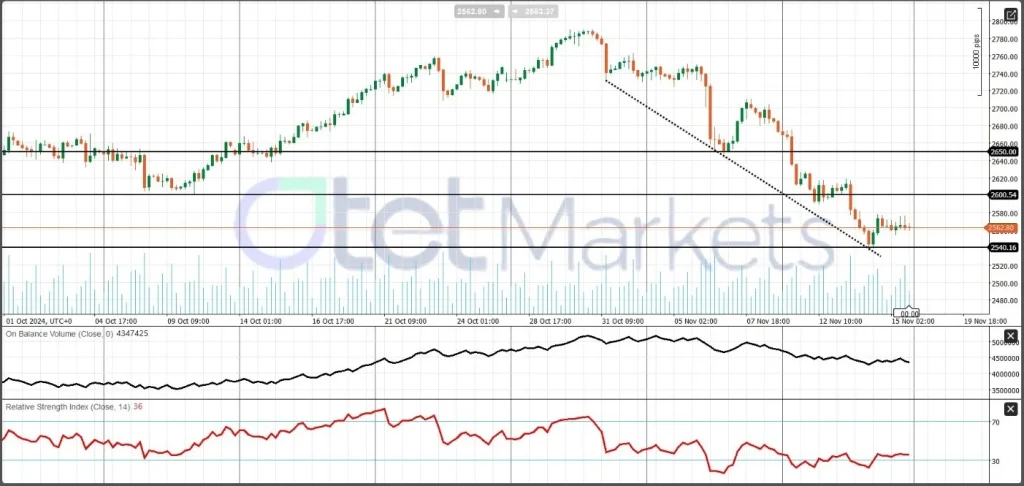
Oil Market Insight: Lower Inventories and OPEC+ decisions!
Crude oil inventories are currently low, potentially supporting higher prices in 2025, as noted in the EIA short-term energy outlook published last week. Following strong performance in 2023, in 2024 oil prices are down only 2% due to weak economic conditions and uncertain demand. In addition, tight global supplies are maintaining pressure on inventories as PPEC+ recently extended its 2 m b/d output cut until the end of January 2025. Historically, declining inventories have correlated with rising oil prices, signaling potential future gains.
Wells Fargo anticipates that a better global economic landscape and stronger demand, especially from China, could push West Texas Intermediate (WTI) crude to $85–$95 per barrel and Brent crude to $90–$100 per barrel in 2025. Factors like China’s efforts to stabilize its property sector may further boost demand. The bank remains optimistic about the energy sector, suggesting that low inventories combined with economic recovery will support higher oil prices.
However, current market dynamics show headwinds. Oil prices recently dropped over 4% weekly due to China’s weaker-than-expected stimulus measures and U.S. inventory builds. U.S. oil inventories rose by 2.1 million barrels last week, above forecasts, raising concerns of a supply glut amid near-record production levels. The election of Donald Trump, who has promised pro-drilling policies, adds further uncertainty to production forecasts.
Despite concerns about a potential 2025 supply glut, as indicated by the International Energy Agency (IEA), UBS analysts argue that market sentiment may be overly pessimistic. UBS reduced its 2025 Brent price target to $80/bbl but noted that actual production growth depends on prevailing spot prices rather than solely on political policies, with energy companies maintaining capital discipline despite political shifts.
In addition to economic data and estimates, geopolitical tensions in the Middle East remain high with no optimistic outlook, which can maintain concerns and support oil prices.
From a technical point of view, WTI has breached its key pivot at $67. If the price cannot recover above that level, bears could lead the market toward much lower levels. On the flip side, a recovery above $67 could set $69 as the next target, followed by $72.
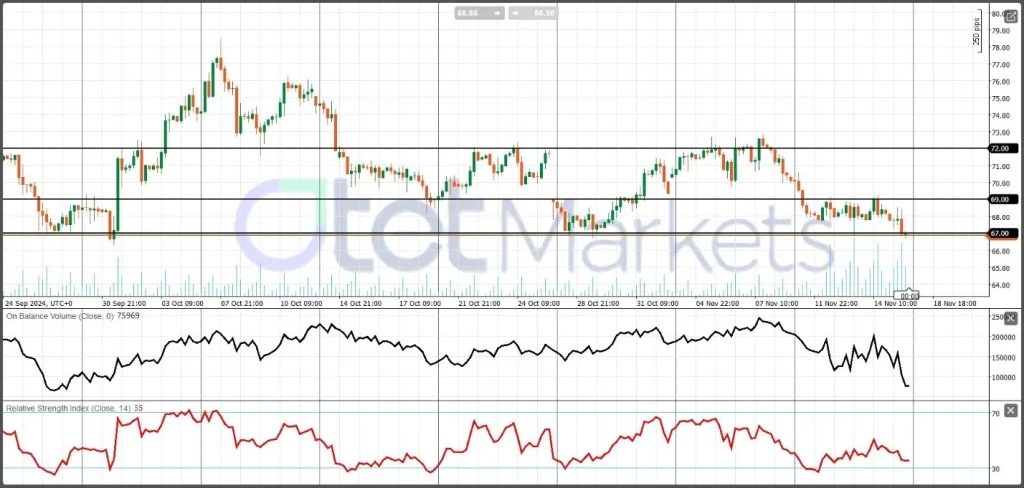
Bitcoin
Bitcoin has shown a strong upward trend since late October, as indicated by the rising price and the upward slope of the Triangular Moving Average (TMA). In the most recent days, the price has been consolidating, forming a range between approximately 91,700 and 91,000.
The dots of the Parabolic SAR are currently above the price bars, suggesting a potential downtrend or a reversal from the previous uptrend. This could be a signal for traders to consider taking profits or to watch for potential sell signals. The Triangular Moving Average (TMA) is sloping upwards and is currently below the price, reinforcing the overall bullish trend in the medium term. It could act as a dynamic support level. The Price Volume Trend indicator has been rising, indicating that the price increase is supported by volume, which is a bullish sign.
The immediate resistance can be identified around the 91,700 level, where the price has peaked multiple times in recent days. The first level of support is around the 86,250 level, where the TMA is currently positioned. This level has also historically acted as both resistance and support, indicating its significance. Further support may be found around 73,300 and 70,000, which are marked by horizontal lines on the chart. These levels could have historical significance based on past price interactions.
The consolidation pattern seen in the most recent days could be indicative of a distribution phase or a temporary pause in the trend before a continuation or reversal. The outcome would depend on upcoming price action and volume changes.
Conclusion and Potential Strategy
- Bullish Scenario: If the price breaks above the 91,700 resistance with significant volume, it could indicate a continuation of the uptrend.
- Bearish Scenario: A break below the TMA line and the 86,250 support level could signal a deeper correction or a trend reversal.
- Watching Volume: It would be crucial to monitor the volume accompanying any breakout or breakdown to confirm the strength of the move.
This analysis is based on the current chart setup and should be used in conjunction with other fundamental and technical analysis tools for making any trading decisions.

Share
Hot topics

What Is the US Dollar Index (DXY) in Forex?
If you’ve spent any time exploring global markets, you’ve certainly heard about the US Dollar Index, known as DXY. For many beginner traders, it appears to be one of those...
Read more




Submit comment
Your email address will not be published. Required fields are marked *